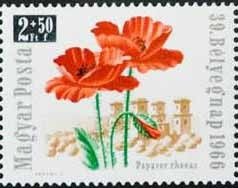Stamp: 39th Stamp Day - Poppies and Diósgyőr Castle (Hungary 1966)
39th Stamp Day - Poppies and Diósgyőr Castle (Hungary 1966)
16 September (Hungary ) within release Stamp Day goes into circulation Stamp 39th Stamp Day - Poppies and Diósgyőr Castle face value 2+0.50 Hungarian forint
| Stamp 39th Stamp Day - Poppies and Diósgyőr Castle in catalogues | |
|---|---|
| Michel: | Mi:HU 2273A |
| Stamp Number: | Sn:HU B261 |
Stamp is square format.
Also in the issue Stamp Day:
- Stamp - 39th Stamp Day - Woman archer face value 2+0.50;
- Stamp - 39th Stamp Day - Grape and lake Balaton face value 2+0.50;
- Stamp - 39th Stamp Day - Poppies and Diósgyőr Castle face value 2+0.50;
- Stamp - Russian Space Dogs (Canis lupus familiaris) face value 2+0.50;
- Souvenir Sheet - 39th Stamp Day face value 8+2;
- Mini Sheet - Stamp day 1966 face value 20*(2+0.50);
- Se-tenant - Stamp Day 1966 face value 8+2;
- Stamp - Stamp day 1966 face value 2+0.50;
- Stamp - Stamp day 1966 face value 2+0.50;
- Stamp - Stamp day 1966 face value 2+0.50;
- Stamp - Stamp day 1966 face value 2+0.50;
- Stamp - Stamp day 1966 face value 2+0.50;
- Stamp - Stamp day 1966 face value 2+0.50;
- Stamp - Stamp day 1966 face value 2+0.50;
- Stamp - Stamp day 1966 face value 2+0.50;
- Se-tenant - Stamp Day 1966 face value 4*(2+0.50);
Stamp 39th Stamp Day - Poppies and Diósgyőr Castle it reflects the thematic directions:
A flower, sometimes known as a bloom or blossom, is the reproductive structure found in plants that are floral (plants of the division Magnoliophyta, also called angiosperms). The biological function of a flower is to effect reproduction, usually by providing a mechanism for the union of sperm with eggs. Flowers may facilitate outcrossing (fusion of sperm and eggs from different individuals in a population) or allow selfing (fusion of sperm and egg from the same flower). Some flowers produce diaspores without fertilization (parthenocarpy). Flowers contain sporangia and are the site where gametophytes develop. Many flowers have evolved to be attractive to animals, so as to cause them to be vectors for the transfer of pollen. After fertilization, the ovary of the flower develops into fruit containing seeds. In addition to facilitating the reproduction of flowering plants, flowers have long been admired and used by humans to beautify their environment, and also as objects of romance, ritual, religion, medicine and as a source of food.
A castle (from Latin: castellum) is a type of fortified structure built in Europe and the Middle East during the Middle Ages by European nobility. Scholars debate the scope of the word castle, but usually consider it to be the private fortified residence of a lord or noble. This is distinct from a palace, which is not fortified; from a fortress, which was not always a residence for nobility; and from a fortified settlement, which was a public defence – though there are many similarities among these types of construction. Usage of the term has varied over time and has been applied to structures as diverse as hill forts and country houses. Over the approximately 900 years that castles were built, they took on a great many forms with many different features, although some, such as curtain walls and arrowslits, were commonplace.
Flora is the plant life occurring in a particular region or time, generally the naturally occurring or indigenous—native plant life. The corresponding term for animal life is fauna. Flora, fauna and other forms of life such as fungi are collectively referred to as biota. Sometimes bacteria and fungi are also referred to as flora, as in the terms gut flora or skin flora.



